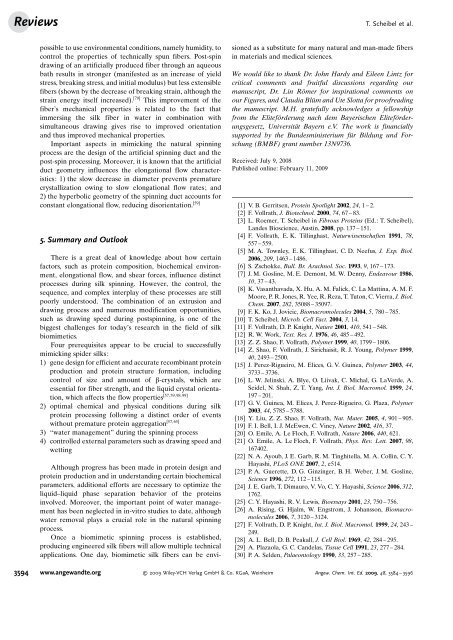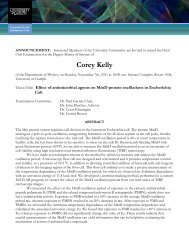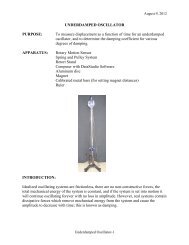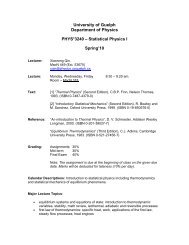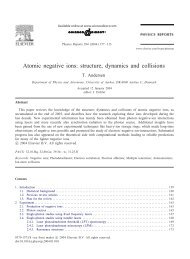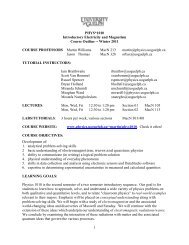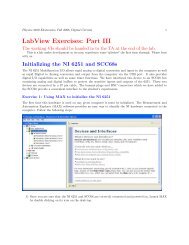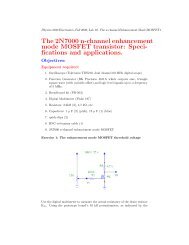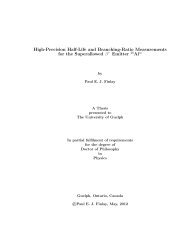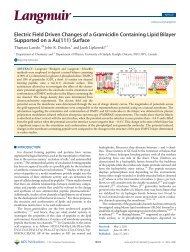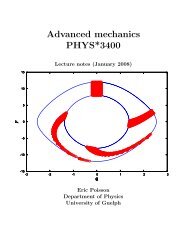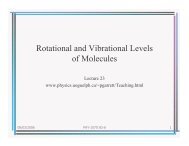Spider Silk: From Soluble Protein to Extraordinary Fiber - Physics
Spider Silk: From Soluble Protein to Extraordinary Fiber - Physics
Spider Silk: From Soluble Protein to Extraordinary Fiber - Physics
Create successful ePaper yourself
Turn your PDF publications into a flip-book with our unique Google optimized e-Paper software.
Reviews<br />
possible <strong>to</strong> use environmental conditions, namely humidity, <strong>to</strong><br />
control the properties of technically spun fibers. Post-spin<br />
drawing of an artificially produced fiber through an aqueous<br />
bath results in stronger (manifested as an increase of yield<br />
stress, breaking stress, and initial modulus) but less extensible<br />
fibers (shown by the decrease of breaking strain, although the<br />
strain energy itself increased). [79] This improvement of the<br />
fiber s mechanical properties is related <strong>to</strong> the fact that<br />
immersing the silk fiber in water in combination with<br />
simultaneous drawing gives rise <strong>to</strong> improved orientation<br />
and thus improved mechanical properties.<br />
Important aspects in mimicking the natural spinning<br />
process are the design of the artificial spinning duct and the<br />
post-spin processing. Moreover, it is known that the artificial<br />
duct geometry influences the elongational flow characteristics:<br />
1) the slow decrease in diameter prevents premature<br />
crystallization owing <strong>to</strong> slow elongational flow rates; and<br />
2) the hyperbolic geometry of the spinning duct accounts for<br />
constant elongational flow, reducing disorientation. [59]<br />
5. Summary and Outlook<br />
There is a great deal of knowledge about how certain<br />
fac<strong>to</strong>rs, such as protein composition, biochemical environment,<br />
elongational flow, and shear forces, influence distinct<br />
processes during silk spinning. However, the control, the<br />
sequence, and complex interplay of these processes are still<br />
poorly unders<strong>to</strong>od. The combination of an extrusion and<br />
drawing process and numerous modification opportunities,<br />
such as drawing speed during postspinning, is one of the<br />
biggest challenges for <strong>to</strong>day s research in the field of silk<br />
biomimetics.<br />
Four prerequisites appear <strong>to</strong> be crucial <strong>to</strong> successfully<br />
mimicking spider silks:<br />
1) gene design for efficient and accurate recombinant protein<br />
production and protein structure formation, including<br />
control of size and amount of b-crystals, which are<br />
essential for fiber strength, and the liquid crystal orienta-<br />
[57, 59, 98, 99]<br />
tion, which affects the flow properties<br />
2) optimal chemical and physical conditions during silk<br />
protein processing following a distinct order of events<br />
[57, 65]<br />
without premature protein aggregation<br />
3) “water management” during the spinning process<br />
4) controlled external parameters such as drawing speed and<br />
wetting<br />
Although progress has been made in protein design and<br />
protein production and in understanding certain biochemical<br />
parameters, additional efforts are necessary <strong>to</strong> optimize the<br />
liquid–liquid phase separation behavior of the proteins<br />
involved. Moreover, the important point of water management<br />
has been neglected in in-vitro studies <strong>to</strong> date, although<br />
water removal plays a crucial role in the natural spinning<br />
process.<br />
Once a biomimetic spinning process is established,<br />
producing engineered silk fibers will allow multiple technical<br />
applications. One day, biomimetic silk fibers can be envi-<br />
sioned as a substitute for many natural and man-made fibers<br />
in materials and medical sciences.<br />
We would like <strong>to</strong> thank Dr. John Hardy and Eileen Lintz for<br />
critical comments and fruitful discussions regarding our<br />
manuscript, Dr. Lin Römer for inspirational comments on<br />
our Figures, and Claudia Blüm and Ute Slotta for proofreading<br />
the manuscript. M.H. gratefully acknowledges a fellowship<br />
from the Eliteförderung nach dem Bayerischen Eliteförderungsgesetz,<br />
Universität Bayern e.V. The work is financially<br />
supported by the Bundesministerium für Bildung und Forschung<br />
(BMBF) grant number 13N9736.<br />
Received: July 9, 2008<br />
Published online: February 11, 2009<br />
T. Scheibel et al.<br />
[1] V. B. Gerritsen, <strong>Protein</strong> Spotlight 2002, 24, 1–2.<br />
[2] F. Vollrath, J. Biotechnol. 2000, 74, 67 – 83.<br />
[3] L. Roemer, T. Scheibel in Fibrous <strong>Protein</strong>s (Ed.: T. Scheibel),<br />
Landes Bioscience, Austin, 2008, pp. 137 – 151.<br />
[4] F. Vollrath, E. K. Tillinghast, Naturwissenschaften 1991, 78,<br />
557 – 559.<br />
[5] M. A. Townley, E. K. Tillinghast, C. D. Neefus, J. Exp. Biol.<br />
2006, 209, 1463 – 1486.<br />
[6] S. Zschokke, Bull. Br. Arachnol. Soc. 1993, 9, 167 – 173.<br />
[7] J. M. Gosline, M. E. Demont, M. W. Denny, Endeavour 1986,<br />
10, 37 – 43.<br />
[8] K. Vasanthavada, X. Hu, A. M. Falick, C. La Mattina, A. M. F.<br />
Moore, P. R. Jones, R. Yee, R. Reza, T. Tu<strong>to</strong>n, C. Vierra, J. Biol.<br />
Chem. 2007, 282, 35088 – 35097.<br />
[9] F. K. Ko, J. Jovicic, Biomacromolecules 2004, 5, 780 – 785.<br />
[10] T. Scheibel, Microb. Cell Fact. 2004, 3, 14.<br />
[11] F. Vollrath, D. P. Knight, Nature 2001, 410, 541 – 548.<br />
[12] R. W. Work, Text. Res. J. 1976, 46, 485 – 492.<br />
[13] Z. Z. Shao, F. Vollrath, Polymer 1999, 40, 1799 – 1806.<br />
[14] Z. Shao, F. Vollrath, J. Sirichaisit, R. J. Young, Polymer 1999,<br />
40, 2493 – 2500.<br />
[15] J. Perez-Rigueiro, M. Elices, G. V. Guinea, Polymer 2003, 44,<br />
3733 – 3736.<br />
[16] L. W. Jelinski, A. Blye, O. Liivak, C. Michal, G. LaVerde, A.<br />
Seidel, N. Shah, Z. T. Yang, Int. J. Biol. Macromol. 1999, 24,<br />
197 – 201.<br />
[17] G. V. Guinea, M. Elices, J. Perez-Rigueiro, G. Plaza, Polymer<br />
2003, 44, 5785 – 5788.<br />
[18] Y. Liu, Z. Z. Shao, F. Vollrath, Nat. Mater. 2005, 4, 901 – 905.<br />
[19] F. I. Bell, I. J. McEwen, C. Viney, Nature 2002, 416, 37.<br />
[20] O. Emile, A. Le Floch, F. Vollrath, Nature 2006, 440, 621.<br />
[21] O. Emile, A. Le Floch, F. Vollrath, Phys. Rev. Lett. 2007, 98,<br />
167402.<br />
[22] N. A. Ayoub, J. E. Garb, R. M. Tinghitella, M. A. Collin, C. Y.<br />
Hayashi, PLoS ONE 2007, 2, e514.<br />
[23] P. A. Guerette, D. G. Ginzinger, B. H. Weber, J. M. Gosline,<br />
Science 1996, 272, 112 – 115.<br />
[24] J. E. Garb, T. Dimauro, V. Vo, C. Y. Hayashi, Science 2006, 312,<br />
1762.<br />
[25] C. Y. Hayashi, R. V. Lewis, Bioessays 2001, 23, 750 – 756.<br />
[26] A. Rising, G. Hjalm, W. Engstrom, J. Johansson, Biomacromolecules<br />
2006, 7, 3120 – 3124.<br />
[27] F. Vollrath, D. P. Knight, Int. J. Biol. Macromol. 1999, 24, 243 –<br />
249.<br />
[28] A. L. Bell, D. B. Peakall, J. Cell Biol. 1969, 42, 284 – 295.<br />
[29] A. Plazaola, G. C. Candelas, Tissue Cell 1991, 23, 277 – 284.<br />
[30] P. A. Selden, Palaeon<strong>to</strong>logy 1990, 33, 257 – 285.<br />
3594 www.angewandte.org 2009 Wiley-VCH Verlag GmbH & Co. KGaA, Weinheim Angew. Chem. Int. Ed. 2009, 48, 3584 – 3596


